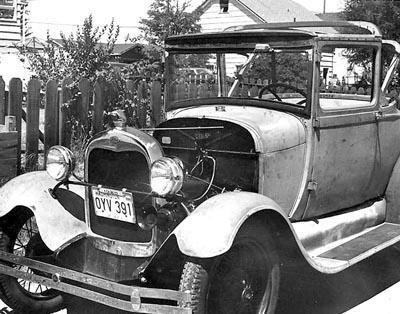A story about trucks - Part III
The sweet sound of that new 4-cylinder motor burped to life, (completed with the funny exhaust whistle) and I eased out the clutch until the half-refurbished car began to roll.
Tue, 05/06/2008
I had the gas pedal nearly pegged to the floorboards to get the tired old pickup up to speed as I roared and rattled up the Maple Valley highway towards home.
And well before I arrived with my long sought after prize, I had concocted a plan to meld my two favorite trucks into one perfect throwback as a tribute to my youth.
I would take the box bed off of this '76 F250 and put on a new flatbed, so that it would have the neat lines of the tough truck I loved as a kid along with the maximized load capacity of my old '56 Flatbed.
The canvas of freshly varnished wooden side boards would be where I could lavish new artwork and bring "Beets Walkin" back to life.
There is great satisfaction in working your tools on a simple and well designed machine. Before a week had gone by, I had the rusted door removed and replaced with a better junkyard part, and I had bids on Ebay for a new dashboard, seat and steering wheel.
Much of the fun of car or truck restoration is in the planning and the envisioning of the goal, and with a small amount of dollars invested I know from previous projects that by summer, I will have this truck sharp and shiny and ready to roll.
The previous projects I'm talking about began back when I was a kid, when Dad got a whim and found a 1928 Model A Soft Top Coupe in the paper.
It was just a few blocks away from our house and I distinctly and fondly remember picking the car up with Dad, and driving it home together, buckets for seats, no top, and a fair amount of dents and rust, but all for only 450 dollars.
We spent numerous evenings after dinner, Dad and I, out in the shop removing rusted bolts and installing odd looking parts.
Dad would occasionally produce a box that had a new steering wheel or an original Aah-Ooga horn in it, most of the stuff coming from the great J.C. Whitney catalog.
We rebuilt the engine with help from a friend and after installing it, Dad popped a special little tweeter-whistle into the end of the new exhaust.
"This'll make it sound authentic, boy!" and he leaned on the Aah-Ooga for emphasis.
The day soon came when we fired it up and moved it out of the garage and Dad let me, a greenhorn 15 year old pre-driving school kid, do the honors.
Dad showed me how to work the spark advance and gears again and I hit the starter button.
The sweet sound of that new 4-cylinder motor burped to life, (completed with the funny exhaust whistle) and I eased out the clutch until the half-refurbished car began to roll. What a thrill, feeling it rumbling and shuddering and before I knew it I was rolling down the driveway.
We took the '28 down to the body shop and let the autobody men there work the swoopy fenders back into shape while Dad arranged for new seat upholstery and a new top.
When I turned 16 and got my driver's permit, Dad let me drive the Model A around town and to school and I made a lot of friends who thought I was cool, if a little strange.
One friend, Joel Wattum, had his own Model A too, and we would park them together on the days when we both were allowed to drive them.
Though it was a vintage, classic car, I had to do my own modification and this resulted in a used 8-track stereo.
The electrical system on the old car was only 6 volts, and the tape player need 12 volts to operate, so I plunked a car battery into the rumble seat and taped the wires to the terminal posts.
It worked great, playing Rolling Stones and The Who at full volume, until the battery ran down and the rock and rollers began to sound demonic and gutteral, and finally the tape stopped playing altogether.
But this classic 1928 coupe was my introduction into car restoration, and the fun and the pleasure derived from the elbow grease has stayed with me, enough so that I have now restored two motorcycles and a sports car to date, and, with desire, no end in sight.


